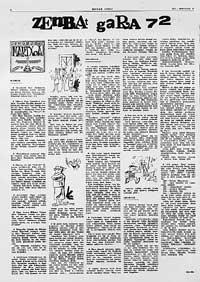How much we are the chronicle of yesteryear Amatiño
1997/11/01 Amatiño Iturria: Elhuyar aldizkaria
HOW WE ARE the chronicle of yesteryear Amatiño

Twenty-five years ago, specifically in the summer of 1972, Miren Jone Azurtza of Zeruko Argia, Edorta Kortadi and a third that I never remember came to Eibar at the door, to see if every week I would chronicle Euskal Herria. It had been for years, five or six long, making those of the correspondent in Eibar and wanted to continue in the same or in the same line, that is, offering short news with little fluidity, with a lot of life, few words of milk and the greatest number of news possible.
On the one hand, yes, instead of ascribing Eibar and its surroundings exclusively to the whole Basque Country that would be in my hand, hereafter. I don't think that conversation would last more than ten minutes or that to convince me they would have to immerse me in great seas without remains. Somewhere they came to express what I wanted to hear and, after seeing the first words, everyone could spare. Without further ado, this is how the department Zenbat Gara emerged next fall, which was born almost by chance and for three years became one of the most important informative references of the week of Basque readers.
The name of the department was due to the well-known song of Benito Lertxundi, Zenbat Gara: How much do you stay? Four, one, three, five, seven... Then, twenty-five years later, this year, I have known that although the song was by Benito, the lyrics were by Abel Muniategi, of course, but then at least we remembered the oriotarra and, precisely, the message that was transmitted in his festivals and records, the number of Basques that we are, the Basque readers and the Basque fans.
Without a doubt, Zenbat Gara was the most read information section at the time in Basque. I was surprised by the success of that weekly chronicle and, in just three years, the evil “Amatiño” became much better known, prestigious and true than Luis Alberto Aranberri himself. As an example, just leave Zeruko Argia and start working in the newspaper Deia in 1977, the address asked me to write an article about Sabino Arana and I wrote it and, many of the chinchos, I signed it with my name and surname. However, chief editor José Manuel Alonso, current director of El Periódico de Alava, told me: “Joé, Amatiño, what does that come from signing with pseudonym?”
I said that the department had achieved great success and now, twenty-five years later, I think I also know why that success. But then I did not know, I do not know if anyone knew it, but I at least did not. Now, like the dam that has gone the water, we can investigate a series of stylistic and sociological arguments, if it is to analyze the reasons that can make understand that phenomenon that happened unexpectedly, but, in the best of cases, they are only simple theories that we can structure among all, since I was not aware of what I was doing, I only did what I knew to do without class, and if it was brought and coming, it was not.

First, the current reader who wants to understand the Basque magazines of the time will have to realize that at that time there was hardly any written information in Basque, at least a complete information. The weekly papers were basically composed of writers' opinion articles and little was done about the reporting work, since there were no reporters and much less Basque journalists licensed at the University. That is, to a large extent, at least in the south, Basque journalism is a communicative and literary genre that emerged during the 1970s.
In some ways, to be expressed in terms and in brief: the weekly Zeruko Argia, until then, was a publication composed of several collections of articles by writers, essayists, priests, professors, university students and thinkers; in 1972 the journalistic work of the first week was created, together with the department of Zenbat Gara, and formulas of information, reports and interviews that were materialized in the next three years. In 1976 Zeruko Argia became a general information magazine, with its current format, and in 1977 the new newspapers Deia and Egin emerged, which took advantage of the experience of the first Basque journalists who in previous years appropriated the trade in Zeruko Argia.
I was 27 years old, married and with two children, when I started Zenbat Gara and did not consider myself a journalist, neither of studies nor of studies. It was Perito Barantilla and in the dry cleaning my father worked. In Bilbao and Madrid I was learning to wash, dye and smooth dirty clothes from others, my father owed him Vasquismo and my mother the fondness for reading. In proportion he gained much more than now, he was a son of good family and, by then, he had a fully oriented life... Until the appearance of Miren Jone Azurtza.
Miren Jone Azurtza, Mikel Atxaga, Mikel Ugalde, Donato Unanue and the rest made me immerse myself in the line of journalist who liked my own... and then me. If they were not, Zenbat Gara would not be created, neither would I the best Basque journalist in 1974 win the prize “Kirikiño”, nor did the offer of work of the newspaper Deia be received, nor would it be part of the Basque General Council and the Basque Government, nor did it participate actively in the creation of HABE and ETB, not surely in politics.
Therefore, if there hadn't been Zenbat Gara, I would surely continue to work in my family's dye, quieter and making more money, but without trying or holding the salty arrows of the most amateurs.

Among other things, this department became the essential unitary reference of the Basques. Perhaps it was not too difficult, because the Basques of that time, in general, were only a large family that used to be well arranged together. But, in any case, he collected Basque readers from different origins, levels and wisdom. The associations and organizations that wanted to make their activities known immediately realized where the information would be sent so that people could read it, who wanted to know what was happening in the Basque language area knew where to find and read it and the most common and curious questions (meetings, addresses, relations, linguistic rules, baptisms, publications of books, all kinds of consultations, etc. ). The reader I wanted to do also had where to go, where to ask and who to write.
It was the last years of the dictatorship (Franco died in 1975), the democratic transition that had to overcome quickly, the Basque Country in full swing, the cultural action that flourished in the last twenty years, the informative dream of the Basques and the department of Zenbat Gara, by chance or by the flow of that process, was placed in the same line. In addition, the oral newspapers, which continued in the routine of the dictatorship, cost them enough to give up the new times that came and for a few years the Basque weeklies could offer more information than the erdales newspapers.
All sources of information of one kind and another took place. This does not mean absolute neutrality between lines. As Koldo Mitxelena wrote to me, “everyone has been able to look for him, but some have wanted to look for him more often than others.” And he believes that it was not his own who most wanted to find me.
Still, thirty-five years later, between Bilbao and Baiona, from time to time, unknown people come to me on any side of the street, remembering that they were the great readers of Zenbat Gara: “That’s it…”, “Every week we were waiting…”, “They the days after…”, “Why don’t you write now?” It seems that the line of then has ever been lost or ever. And especially every time I hear this last question I ask myself: Have readers lost me or I lost my readers? Or, in other words, is there anything that readers read of all colors, ages and levels in current Basque journalism?
Details of the apartmentIt is not easy to explain to the current reader the meaning of that series Zenbat Gara, which lasted only three and a half years between 1972 and 1975. However, some details are summarized below:
|

Gai honi buruzko eduki gehiago
Elhuyarrek garatutako teknologia






